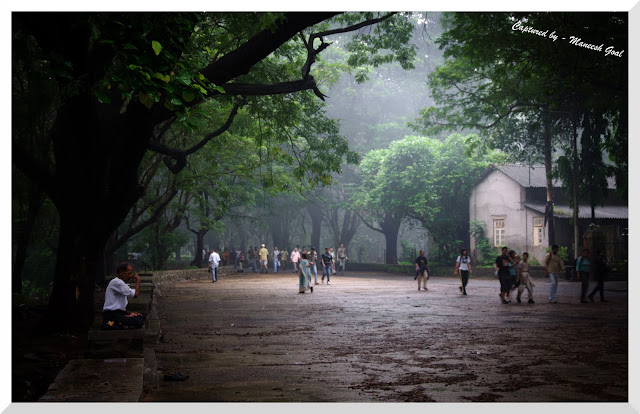Mumbai, aptly called Maximum City by Suketu Mehta in his book by the same name, is a city of contrasts. One such element is the presence of a National Park in the midst of what is India's busiest metropolis. Which other metropolis in the world can boast of such a privilege? To most Mumbaikars (especially of the types born and brought up in the city like me), the 104 sq. Km Sanjay Gandhi National Park (SGNP) brings back memories of an unspoilt childhood when our parents would take us to the park on a lazy Sunday for a jungle safari or an excursion to the famed Kanheri Caves (they are 2400 years old!) and of course those lovely school picnics. Alas, as we have grown up, and through the boom years, places such as these have only remained confined to memories for most people.
A visit to the National Park on a rainy Sunday morning, as part of the BNHS Nature Walk, was to me as much about jogging the memory back as about exploring the lesser known areas of the park. Coming after a successful visit to the Maharashtra Nature Park, I was craving for more...
For a slide show of complete set of pictures of Sanjay Gandhi National Park, please click HERE.
Every morning hundreds of people throng to the park for their ritual of exercises - walking, jogging, doing yoga, etc. Being a Sunday, many had also come with their kids for nature watch and safaris. Seeing the crowd outside the gate and the swarm of cars (yes people come in cars to walk! maybe they come from far away places) reminded me of the daily scenes outside the gates of SEEPZ in Andheri! But once inside, it was a completely different world!
The areas of Sanjay Gandhi National Park that are open to public are but only a fraction of the park's total area. Vast portions of the park are restricted and can only be accessed with the permission of the Forest Department. It is in these areas that the park has tucked away the best of its treasures. The Shilonda Trail (also spelled Silonda) is one such area. Nature walks conducted by organisations such as BNHS are the best way to go on these trails without having to undergo the hassle of interacting with forest officials, especially if you are going alone like me.
The entrance to the Shilonda trail begins from about 1 Km inside the park (starting from the Borivali Gate). The muddy unpaved trail extends Eastward from its entry point towards the main North-South ridge that rises towards Kanheri Hill (the highest point above sea-level in Mumbai). It is a trail lined with bamboo groves, scrub and tall forests, termite mounds, Pongam oil tree, and also has a small forest river cutting across it. During monsoons, the river is wild and the forest dense & green. It makes for excellent nature watch - plants, butterflies, bugs, spiders, birds, flowers, wild fruits, monkeys (Rhesus Macaques - how can one forget them) and other varieties of insects. Its sylvan and verdant design, teeming with numerous habitants, makes Shilonda an ideal place for nature and macro photography. The hoots of Greater Coucal provide an excellent departure from the cacophonous sounds of mobile phones.
The forest river, which bulges in the monsoon, is a place to spend a nice 1 hour or more. Observe grown ups turn into kids, photograph some candid moments and indulge in your own revelry as well! It is indeed impossible to believe that one is still within the limits of Greater Mumbai!
 |
| Flower that saved us! |
We had begun the trail at about 8.00 AM (starting at 7:30 AM from the main gate) and it was now 11.00 AM when we emerged out of the Shilonda trail and were back on the main concrete road of the National Park. Now the place was lined with local villagers (yes there are a few villages located inside the park) selling roasted corn, sliced cucumber & tomatoes and fruits to the health conscious people who come for their daily dose of exercise. These scenes also provide excellent opportunities for street photography (also see my previous post).
By 11:30 AM I was at the gates, staring at the traffic and ready to head back home after a Sunday morning well spent - completely refreshed and recharged to take on the turbulent financial markets from Monday onwards! All this without stepping a foot outside Mumbai!
In every walk with nature one receives far more than he seeks - John Muir
About Sanjay Gandhi National Park: SGNP, also called Borivali National Park, is a protected area located in North Mumbai. Its main entrance is located on the Western Express Highway in the suburb of Borivali. The place is very easily accessible from any corner of Mumbai by trains, buses and cabs. The entry fee (without a car and for non-commercial photographers) is a mere Rs. 20/- (less than half a dollar!). The park touches most of the Northern suburbs of Mumbai including Mulund, the place where I reside. I have grown up watching the hills (very clearly visible from the windows of my house) that form part of the park. As a teenager I have also gone trekking in those hills (we would begin our ascent from a hillock behind Veena Nagar, which has now been razed to make way for a residential tower!!!). From the top of the hill (it is the tallest of all the suburbs) one can catch a sweeping view of the North-Eastern suburbs as well as the Tulsi Lake which is located just behind the hill.
A highly recommended place for nature lovers!




2.jpg)



















